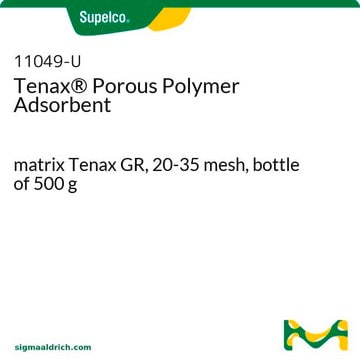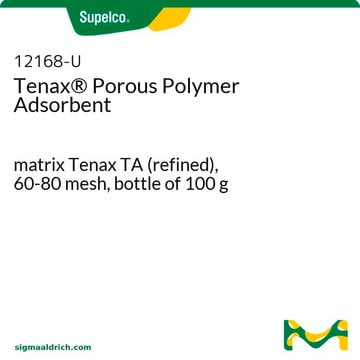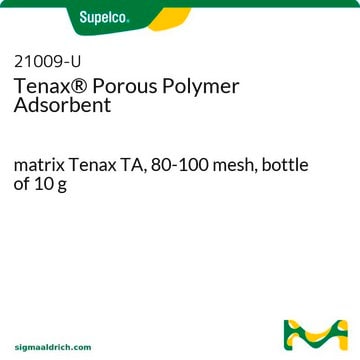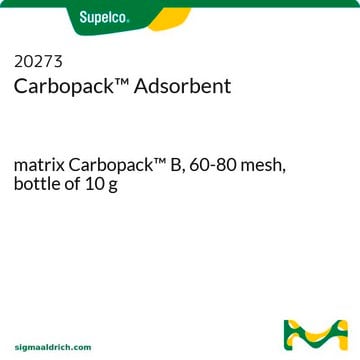Products may be shipped at a different temperature than the recommended long-term storage temperature. If the product quality is sensitive to short-term exposure to conditions other than the recommended long-term storage, it will be shipped on wet or dry-ice. If the product quality is NOT affected by short-term exposure to conditions other than the recommended long-term storage, it will be shipped at ambient temperature. As shipping routes are configured for minimum transit times, shipping at ambient temperature helps control shipping costs for our customers. For more information, please refer to the Storage and Transport Conditions document: https://www.sigmaaldrich.com/deepweb/assets/sigmaaldrich/marketing/global/documents/316/622/storage-transport-conditions-mk.pdf
Wichtige Dokumente
11982
Tenax® poröses Polymeradsorbens
matrix Tenax TA, 60-80 mesh, bottle of 10g
About This Item
Empfohlene Produkte
Produktbezeichnung
Tenax® poröses Polymeradsorbens, matrix Tenax TA, 60-80 mesh, bottle of 10 g
Agentur
suitable for EPA 601
Form
solid
Verpackung
bottle of 10 g
Parameter
350 °C temp. limit
Oberflächenbereich
~35 m2/g
Matrix
Tenax TA
Partikelgröße
60-80 mesh
Dichte
~0.25 g/mL (free fall density)
Suchen Sie nach ähnlichen Produkten? Aufrufen Leitfaden zum Produktvergleich
Allgemeine Beschreibung
Weitere Informationen über unsere Adsorbentien finden Sie auf sigma-aldrich.com/adsorbents
Anwendung
- Für flüchtige organische Verbindungen (VOC) in unterschiedlichen Mikroumgebungen vor deren Bestimmung durch Kurzweg-Thermodesorption (SPTD) und Gaschromatographie-Massenspektrometrie (GC-MS) (GC-MS). Für [1]
- C7-C26 Kohlenwasserstoffe in Raumluftproben[2] und zur Bestimmung von VOC in Luftproben aus Werkshallen[3] vor deren Analyse durch TD und anschließender GC-Untersuchung.
Rechtliche Hinweise
Signalwort
Warning
H-Sätze
Gefahreneinstufungen
Eye Irrit. 2 - Skin Irrit. 2 - STOT SE 3
Zielorgane
Respiratory system
Lagerklassenschlüssel
11 - Combustible Solids
WGK
WGK 3
Flammpunkt (°F)
Not applicable
Flammpunkt (°C)
Not applicable
Persönliche Schutzausrüstung
dust mask type N95 (US), Eyeshields, Gloves
Hier finden Sie alle aktuellen Versionen:
Analysenzertifikate (COA)
It looks like we've run into a problem, but you can still download Certificates of Analysis from our Dokumente section.
Wenn Sie Hilfe benötigen, wenden Sie sich bitte an Kundensupport
Besitzen Sie dieses Produkt bereits?
In der Dokumentenbibliothek finden Sie die Dokumentation zu den Produkten, die Sie kürzlich erworben haben.
Kunden haben sich ebenfalls angesehen
Verwandter Inhalt
This page is intended to make it easier to find the consumables you need based on the analytical method you’re using. Methods included on this page come from the EPA, Standard Methods and ASTM.
-
How is shipping temperature determined? And how is it related to the product storage temperature?
1 Antwort-
Hilfreich?
-
-
How can I determine the shelf life / expiration / retest date of this product?
1 Antwort-
If this product has an expiration or retest date, it will be shown on the Certificate of Analysis (COA, CofA). If there is no retest or expiration date listed on the product's COA, we do not have suitable stability data to determine a shelf life. For these products, the only date on the COA will be the release date; a retest, expiration, or use-by-date will not be displayed.
For all products, we recommend handling per defined conditions as printed in our product literature and website product descriptions. We recommend that products should be routinely inspected by customers to ensure they perform as expected.
For products without retest or expiration dates, our standard warranty of 1 year from the date of shipment is applicable.
For more information, please refer to the Product Dating Information document: https://www.sigmaaldrich.com/deepweb/assets/sigmaaldrich/marketing/global/documents/449/386/product-dating-information-mk.pdfHilfreich?
-
-
Can tenax be restored in laboratory oven at 40 *C temperature?
1 Antwort-
The Tenax® Porous Polymer Adsorbent can be regenerated by hot-methanol extraction.
Hilfreich?
-
-
What is the Department of Transportation shipping information for this product?
1 Antwort-
Transportation information can be found in Section 14 of the product's (M)SDS.To access the shipping information for this material, use the link on the product detail page for the product.
Hilfreich?
-
-
What solvents can be used for chemical desorption for Product No. 11982, Tenax TA 60-80 mesh?
1 Antwort-
Common solvents like alcohols, ethers, hydrocarbons, and aqueous hydrochloric acid/sodium hydroxide can be used. Don't use chlorinated hydrocarbons like dichloromethane, aromatics like xylene and carbon disulfide. All other solvents not mentioned can be used after checking solubility.
Hilfreich?
-
Aktive Filter
Unser Team von Wissenschaftlern verfügt über Erfahrung in allen Forschungsbereichen einschließlich Life Science, Materialwissenschaften, chemischer Synthese, Chromatographie, Analytik und vielen mehr..
Setzen Sie sich mit dem technischen Dienst in Verbindung.











